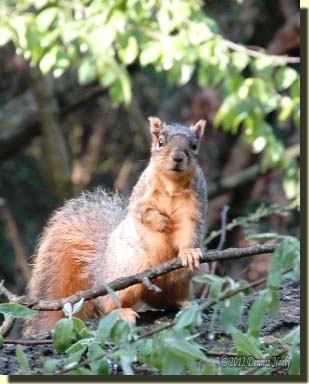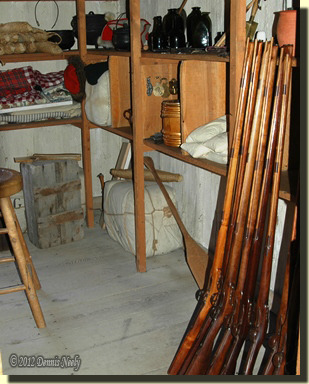Black granules tumbled. The tarnished brass measure filled. Two taps against the Northwest gun’s inner bore freed stragglers, more habit than need. Two palm-sized maple leaves, yellowed and dry, rolled to the size of a death sphere, squeaked as the wiping stick eased them down the bore. Three hard taps pounded the wadding flat and firm.

“Chukk, chukk, chukk, chukk,” a fox squirrel barked, well up in a shagbark hickory on the next knob north. The air smelled damp and a bit humid as the morning’s heavy dew dissipated. The hired hunter’s fingers dug for the cowhide shot bag. In due time a brass measure of squirrel shot rattled down the trade gun’s eager bore. A thumb and forefinger tore the stem from a single maple leaf. Rolled in a like manner, pressed into the muzzle, then tamped firm, the wadding quelled the anxious death bees.
“Tseep, Tseep, Tseep…” a tufted titmouse sang as it bobbed on a scrub-oak sprig. The wiping stick bumped the forestock; with a quick twist and a gentle sigh the warped rod aligned with the bare entry hole.
“Caw, caw, caw, caw…” crows cawed as they winged from the tangled bottoms that lined the east bank of the River Raisin to the tall hardwoods on the west hillside. Elk moccasins began a slow, quiet stalk of the shagbark. Downriver, contented geese ke-honked; now and again a hen mallard cried out, “Wack, wack, wack, wack, wack…” It was a pleasant morning to chase the makings of squirrel stew, in the Year of our Lord, 1795…
How much shot?
Francois Victor Malhiot was 15 years old when he became a clerk for the North West Company. His July 9, 1804 entry contains an accounting of the trade goods in his charge:

“…an outfit of eleven assorted bales, twenty kegs of rum double strength, four kegs of powder, five bags of shot and bullets, half a bale of kettles, a case of guns, twelve traps and four rolls of tobacco, the whole entrusted to my care by Mr. William Mac Gillivray to be traded for furs in the Department of Montreal River. Moreover, I was supplied with as many French provisions as a proprietor might wish for, [missing word] four hundred pounds of flour, two barrels and a half of pork, forty pounds of biscuit, a Keg of shrub, a Keg of high-wines, two of sugar, four pounds of tea, a ham, bread butter, etc. etc…” (Malhoit, 166 – 168).
Malhoit’s account ledgers give a sense of the value of these trade goods and commodities. “…a Double handful of Powder” is booked at a value of “1 Plu,” or one prime beaver pelt, “A Handful of shot” for one beaver (Ibid, 216) and “Sixty bullets” for two beaver (218) or thirty round balls for one Plu.
The question in my mind has always been, “What constituted ‘a handful?’” Is this one cupped hand? Two hands cupped together? Was there a scoop or other utensil used “that equaled ‘a handful’?” And if so, why didn’t the clerks refer to it as “a measure?” What happened when the trader’s hand was smaller than the purchaser’s? Oh, my…
The next question that perplexes me is “How did they carry the shot?” A horn is mentioned for the ‘double handful of powder,’ and the round balls are big enough to remain loose in a shot pouch. I don’t have a problem with a dedicated bag for shot for the hired hunter who cavorts about the forest in the last decade of the 18th century. Both Tami and I have fine leather shot bags designed to hold loose shot, hidden under our Christmas tree by Darrel Lang. They fit the trading post hunter persona.
I’ve tried carrying lead shot loose in Msko-waagosh’s shot pouch, once. That experiment did not work—akin to trying to nail Jello cubes to a wall. Alas, the issue resurfaced as I worked on attributing specific accoutrements for carrying loose shot to each persona. The post hunter is set, thanks to Darrel. I have materials on order for a wilderness classroom experiment with regards to the two returned white captives, and I can’t wait.
And along with the “a handful” dilemma, the question arises, “How much shot to carry?” The whole handful? All that remains from hunting plus that acquired by trade? Enough for one outing? Or a week in the woods?
Upon leaving Philadelphia, John James Audubon lists what he took with him to the forest, including “…25 pounds of shot…” (Audubon, 6). There is no way he carried that much shot on his person while gathering the subjects of his great illustrations. Likewise, there are references in Tanner’s journal and Browning’s narrative to leaving possessions in camp. Right or wrong in a living history sense that is the course my personas have taken.
The post hunter’s shot bag holds five or six doses of lead shot, give or take seven ounces. Before the shot bags from Leather from the Past, I carried that same quantity in a deerskin bag with a whittled spout. That worked for three decades; I never came up short for a day’s hunting. I’m sure I just jinxed an alter ego with that statement, but that has been my experience in the wilderness classroom.
And then again, running out of shot or ball is period-correct, too, as John Tanner relates. And as a safety warning, this is a “don’t try this at home” tale:
“It happened one morning that I went to hunt with only three balls in my pouch, and finding a large buck moose, I fired at him rather hastily, and missed him twice in succession. The third time I hit but did not kill him, only wounding him in the shoulder. I pursued, and at length overtook him, but having no balls, I took the screws out of my gun, tying the lock on with a string, and it was not till after I had shot three of them into him that he fell…” (Tanner, 105)
Give traditional black powder hunting a try, be safe and may God bless you.



One Response to Chasing the Makings of Squirrel Stew